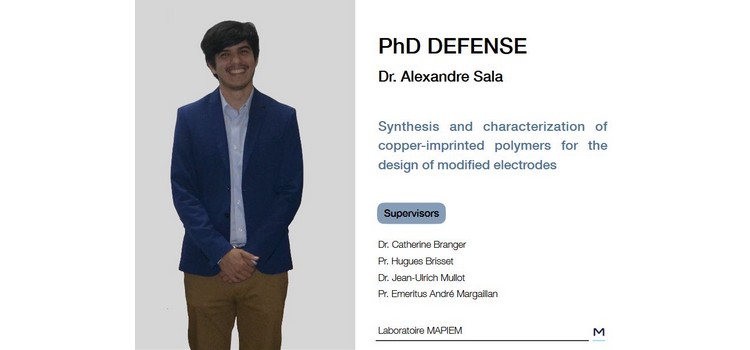PhD thesis defense of Alexandre SALA
Alexandre SALA, PhD student at MAPIEM lab, under the supervision of:
will defend his PhD thesis in Chemistry, specialty Polymers Chemistry and Physico-Chemistry on the topic:
on October 3rd, 2022 at 02:00PM, at the Amphitheatre of Building M, University of Toulon.
before a jury composed of :
- Mme Carole CALAS-BLANCHARD, Professeure, Université de Perpignan, Rapporteur
- M. Benjamin CARBONNIER, Professeur, Université Paris-Est Créteil, Rapporteur
- Mme Véronique LENOBLE, Maître de Conférences, Université de Toulon, Examinatrice
- Mme Maud SAVE, Directrice de recherche, IPREM, Université de Pau, Examinatrice
- M. Jean-Ulrich MULLOT, Docteur, LASEM Toulon, Co-encadrant de thèse
- M. Hugues BRISSET, Professeur, Université de Toulon, Co-directeur de thèse
- Mme Catherine BRANGER, Maître de Conférences-HDR, Université de Toulon, Directrice de thèse
Abstract:
The use of copper as a biocide in anti-fouling coatings on ships has led to its accumulation in harbour waters. The aim of this work is to develop electrochemical sensors for its detection in marine samples. For this purpose, copper(II)-imprinted polymers were prepared and used for the modification of electrodes.
Firstly, imprinted polymer particles were synthesised using a cross-linking agent (ethylene glycol dimethacrylate or N,N’-methylene-bis-acrylamide) and a functional monomer, methacrylamido-L-histidine (MAH), which can form a complex with copper(II). The physico-chemical characterization of the polymer particles confirmed the integration of MAH and allowed to evaluate the morphological properties of the polymers.
The copper(II) binding properties were then evaluated and the particles with the best performance were used to make carbon paste electrodes. These electrodes, with a detection limit of 5.9 x 10-2 µM (or 3.75 µg/L), allowed the determination of copper(II) in marine samples.
Finally, new approaches for surface modification were explored for in situ polymer film formation. Thus, iniferters were grafted onto gold electrodes by the formation of self-assembled monolayers but also by electropolymerisation of a polymer with pendant iniferter functions. The latter route allowed the photopolymerisation of a copper(II)-imprinted polymer film on a carbon electrode.
Keywords
Imprinted polymers, electrochemistry, copper, surface modification, iniferter, electropolymerisation


